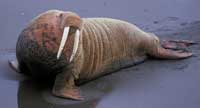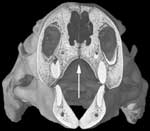Odobenus rosmarus is the only extant species of walrus.  However, Odobenidae was once a diverse group of marine mammals. Odobenidae is defined phylogenetically as the most recent common ancestor of the fossil Neotherium and extant Odobenus, plus all of its descendants (Deméré, 1994a, b; see also Tedford and Repenning, 1977). Odobenidae consists of two subgroups: Dusignathae, which are all fossil taxa from the Miocene of California and Baja California; and Odobeninae, which is composed of both fossils and the extant genus Odobenus. Fossils of odobenines are known from Pliocene deposits on both sides of the Pacific Ocean (Berta and Sumich, 1999).
However, Odobenidae was once a diverse group of marine mammals. Odobenidae is defined phylogenetically as the most recent common ancestor of the fossil Neotherium and extant Odobenus, plus all of its descendants (Deméré, 1994a, b; see also Tedford and Repenning, 1977). Odobenidae consists of two subgroups: Dusignathae, which are all fossil taxa from the Miocene of California and Baja California; and Odobeninae, which is composed of both fossils and the extant genus Odobenus. Fossils of odobenines are known from Pliocene deposits on both sides of the Pacific Ocean (Berta and Sumich, 1999).
The most charismatic feature of walruses is an evergrowing pair of upper canine tusks,  although such tusks only evolved in a single walrus lineage, the Odobenini, to which Odobenus belongs (Deméré, 1994b). Tusks are present in both male and female walruses, but they are more robust in males (Fay, 1985). A single male tusk can achieve a length of one meter, and it may weigh as much as 5.4 kg (Berta and Sumich, 1999). Enamel occurs only at the tip of the tusk, and roughly 80% of the tusk is exposed above the gumline (Nowak, 1991). The tusks in males are generally used for dominance displays during the mating season, but walruses do occasionally use them to haul themselves onto ice floes and drag themselves along the land (Fay, 1985). Although not normally used for feeding, the tusks can be used to disturb sediment during benthic foraging (Berta and Sumich, 1999).
although such tusks only evolved in a single walrus lineage, the Odobenini, to which Odobenus belongs (Deméré, 1994b). Tusks are present in both male and female walruses, but they are more robust in males (Fay, 1985). A single male tusk can achieve a length of one meter, and it may weigh as much as 5.4 kg (Berta and Sumich, 1999). Enamel occurs only at the tip of the tusk, and roughly 80% of the tusk is exposed above the gumline (Nowak, 1991). The tusks in males are generally used for dominance displays during the mating season, but walruses do occasionally use them to haul themselves onto ice floes and drag themselves along the land (Fay, 1985). Although not normally used for feeding, the tusks can be used to disturb sediment during benthic foraging (Berta and Sumich, 1999).
Additional skeletal features of walruses include a large maxilla  to support the massive tusks, absence of a supraorbital process, a prominent antorbital process, an enlarged mastoid process, and a highly vaulted palate for use in suction feeding (Berta and Sumich, 1999; Fay, 1985). Male walruses also have the largest baculum of any mammal, in both absolute (~63 cm) and relative size (Fay, 1985; Nowak, 1991). The typical odobenid dental formula is I1/0, C1/1, P3/3, M0/0. The teeth are well-anchored in the jaw, and the cement on the roots of the cheek teeth of an adult male walrus can contribute up to 90% of the volume of the tooth (Fay, 1985). External characteristics include coarse, brown fur covering thick skin (2-4 cm all over body) and conspicuous mystacial vibrissae. The stiff vibrissae are used to locate prey, and they can be moved as a group, or individually (Berta and Sumich, 1999; Murie, 1871).
to support the massive tusks, absence of a supraorbital process, a prominent antorbital process, an enlarged mastoid process, and a highly vaulted palate for use in suction feeding (Berta and Sumich, 1999; Fay, 1985). Male walruses also have the largest baculum of any mammal, in both absolute (~63 cm) and relative size (Fay, 1985; Nowak, 1991). The typical odobenid dental formula is I1/0, C1/1, P3/3, M0/0. The teeth are well-anchored in the jaw, and the cement on the roots of the cheek teeth of an adult male walrus can contribute up to 90% of the volume of the tooth (Fay, 1985). External characteristics include coarse, brown fur covering thick skin (2-4 cm all over body) and conspicuous mystacial vibrissae. The stiff vibrissae are used to locate prey, and they can be moved as a group, or individually (Berta and Sumich, 1999; Murie, 1871).
Odobenids are benthic foragers, feeding primarily on bivalve mollusks (although walruses do consume the occasional fish or seal; Fay, 1985). Walruses are suction feeders, and they possess the ability to suck the fleshy mollusk out of its shell by using a sophisticated piston system with their tongue and highly vaulted palate (Berta and Sumich, 1999). Because their prey lives in shallow waters, walruses participate in some of the shallowest dives of all pinnipeds (Berta and Sumich, 1999; Gjertz et al., 2001), despite being the largest pinnipeds in overall body size.
Underwater, odobenids propel themselves with their forelimbs, much like Phocidae, the true or earless seals. On land, however, walruses rotate their ankles and are capable of quadrupedal locomotion (Fay, 1985). The ability to walk on land is also characteristic of Otariidae, the eared seals.
Pinnipeds are unquestionably members of Carnivora, but monophyly of Pinnipedia has been contested by many researchers (e.g., McLaren, 1960; Tedford, 1976). Proponents of pinniped diphyly argue that Phocidae arose from mustelid (otter and weasel) stock, whereas Otariidae and Odobenidae arose from ursid (bear) stock. More recent and overpowering data from the cranium (Wyss and Flynn, 1993), postcranium (Wyss, 1988), and biomolecules (Árnason and Ledje, 1993; Árnason and Widgren, 1986; Flynn and Nedbal, 1998; Lento et al., 1995; Sarich, 1969) of pinnipeds support monophyly of Pinnipedia. Cranial evidence for pinniped monophyly includes a jugal widely separated from the lacrimal, failure of the anterior extent of the palatine to contact the lacrimal, and absence of lower incisors (Wyss and Flynn, 1993).
The position of Odobenidae within Pinnipedia is controversial in itself, as walruses share similarities with both phocids and otariids. The issue remains largely unresolved, as anatomical data support an Odobenidae-Phocidae sister relationship (Flynn and Nedbal, 1998; Wyss and Flynn, 1993) while molecular data tend to support an Odobenidae-Otariidae clade (Flynn and Nedbal, 1998; Lento et al., 1995).
Additional Information on the Skull
Click on the thumbnails below for labeled images of the adult skull in standard anatomical views.

Literature
Árnason, Ú. and B. Widegren. 1986. Pinniped phylogeny enlightened by molecular hybridization using highly repetitive DNA. Molecular Biology and Evolution 3:356-365.
Árnason, Ú. and C. Ledje. 1993. The use of highly repetitive DNA for resolving cetacean and pinniped phylogenies. Pp. 74-80 in Szalay, F. S., M. J. Novacek, and M. C. McKenna, eds. Mammal Phylogeny: Placetnals. Springer –Verlag, New York.
Berta, A. and J. L. Sumich. 1999. Marine mammals: evolutionary biology. Academic Press, San Diego, CA. 494 pp.
Deméré, T. A. 1994a. Two new species of fossil walruses (Pinnipedia: Odobenidae) from the Upper Pliocene San Diego Formation, California. Proceedings of the San Diego Society of Natural History 29:77-98.
Deméré, T. A. 1994b. The family Odobenidae: a phylogenetic analysis of fossil and living taxa. Proceedings of the San Diego Society of Natural History 29:99-123.
Fay, F. H. 1985. Odobenus rosmarus. Mammalian Species 238:1-7.
Flynn, J. J. and M. A. Nedbal. 1998. Phylogeny of the Carnivora (Mammalia): congruence vs. incompatibility among multiple data sets. Molecular Phylogenetics and Evolution 9:414-426.
Gjertz, I., D. Griffiths, B. A. Krafft, C. Lydersen, and Ř. Wiig. 2001. Diving and haul-out patterns of walruses Odobenus rosmarus on Svalbard. Polar Biology 24:314-319.
Lento, G. M., R. E. Hickson, G. K. Chambers, and D. Penny. 1995. Use of spectral analysis to test hypotheses on the origin of pinnipeds. Molecular Biology and Evolution 12:28-52.
McLaren, I. A. 1960. Are the Pinnipedia biphyletic? Systematic Zoology 9:18-28.
Murie, J. 1871. Researches upon the anatomy of the Pinnipedia. Part I. On the walrus (Trichechus rosmarus Linn.). Transactions of the Zoological Society of London 7:411-464.
Nowak, R. M. 1991. Walker’s Mammals of the World. Volume II. Fifth edition. The Johns Hopkins University Press, Baltimore. 1629 pp.
Repenning, C. A. and R. H. Tedford. 1977. Otarioid seals of the Neogene. United States Geological Survey Professional Paper 992.
Sarich, V. M. 1969. Pinniped phylogeny. Systematic Zoology 18:416-422.
Tedford, R. H. 1976. Relationship of pinnipeds to other carnivores (Mammalia). Systematic Zoology 25:363-374.
Wyss, A. R. 1988. Evidence from flipper structure for a single origin of pinnipeds. Nature 334:427-428.
Wyss, A. R. and J. J. Flynn. 1993. A phylogenetic analysis and definition of the Carnivora. Pp. 22-52 in Szalay, F. S., M. J. Novacek, and M. C. McKenna, eds. Mammal Phylogeny: Placetnals. Springer –Verlag, New York.
Links
Odobenus rosmarus page on the Animal Diversity Web (University of Michigan Museum of Zoology)
O. rosmarus page from the Seal Conservation Society
underwater O. rosmarus audio from the University of Rhode Island


